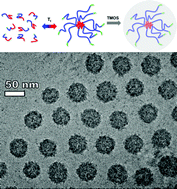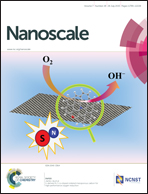Bio-inspired synthesis of hybrid silica nanoparticles templated from elastin-like polypeptide micelles†
Abstract
The programmed self-assembly of block copolymers into higher order nanoscale structures offers many attractive attributes for the development of new nanomaterials for numerous applications including drug delivery and biosensing. The incorporation of biomimetic silaffin peptides in these block copolymers enables the formation of hybrid organic–inorganic materials, which can potentially enhance the utility and stability of self-assembled nanostructures. We demonstrate the design, synthesis and characterization of amphiphilic elastin-like polypeptide (ELP) diblock copolymers that undergo temperature-triggered self-assembly into well-defined spherical micelles. Genetically encoded incorporation of the silaffin R5 peptide at the hydrophilic terminus of the diblock ELP leads to presentation of the silaffin R5 peptide on the coronae of the micelles, which results in localized condensation of silica and the formation of near-monodisperse, discrete, sub-100 nm diameter hybrid ELP-silica particles. This synthesis method, can be carried out under mild reaction conditions suitable for bioactive materials, and will serve as the basis for the development and application of functional nanomaterials. Beyond silicification, the general strategies described herein may also be adapted for the synthesis of other biohybrid nanomaterials as well.


 Please wait while we load your content...
Please wait while we load your content...